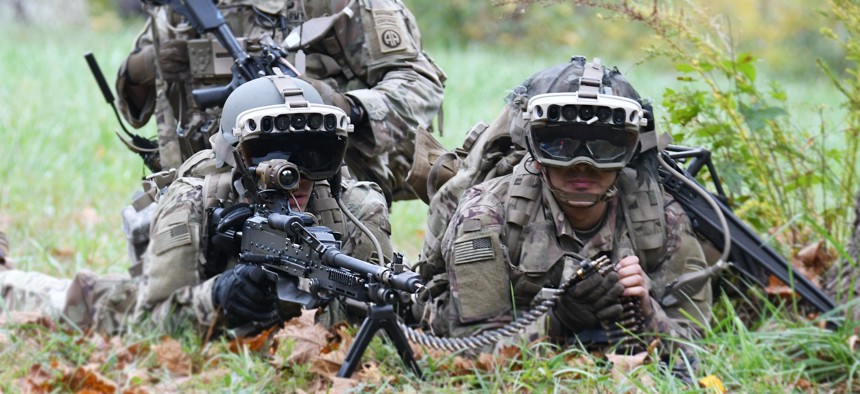
Soldiers from the 82nd Airborne Division used the latest prototype of the Integrated Visual Augmentation System (IVAS) during a training exercise in October 2020 at Fort Pickett, Va. U.S. Army / Bridgett Siter
Army Delays IVAS Display Headset by a Year
Officials cited problems with the unusually wide field of view.
The Army is delaying testing and fielding of its augmented-reality headset while tweaks are made to improve the system, service officials announced Monday.
One of the Army’s top-priority equipment programs, the Integrated Visual Augmentation System, or IVAS, is a heads-up digital display that enables soldiers to view video or other data from a network.
In a statement released on Monday, Army officials disputed a report published last week by Janes that the IVAS program has been halted. The program has merely been delayed, said Karen Saunders, the senior official performing the duties of the assistant Army secretary for acquisition, logistics, and technology; and Gen. John Murray, who leads Army Futures Command.
Top Army officials told Congress in May that the headset would be fielded to its first unit by year’s end. Instead, the operational test will now take place next May and the system’s fielding will happen next September, the statement said.
The headset allows a field of view of 80 degrees, twice that of other ones currently available, according to the statement. But that wider view has some flaws.
“At 80 degrees, IVAS pushed the boundaries of waveguide technology capabilities, and the field of view began to lose resolution. By making minor reductions, developers are finding greater quality and clearer visibility,” the statement says.
Janes also reported that the Pentagon’s inspector general is conducting an audit of the program “to determine whether Army officials are producing and fielding Integrated Visual Augmentation System units that meet capability requirements and user needs,” the notice states.
The Army is working with Microsoft to develop the system, which was based on the technology company’s HoloLens headset. Two years of effort led the Army in March to award Microsoft a contract worth up to $21.88 billion over the next ten years to produce and field the system. The delay will not affect the contract, the statement said.
The statement said that even with the delay, the Army will field IVAS six to 10 years faster than it usually takes to develop and introduce a new piece of gear.
“Calculated risk and time for adjustment have been baked into our processes, and are vital to rapid Army modernization practices,” the statement says. “At this year’s Association of the United States Army annual event we stated, the Army has to be willing to accept some early risk, or we will never be able to keep up with the pace of change required to achieve and maintain overmatch in [multi-domain operations]."




